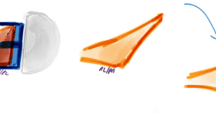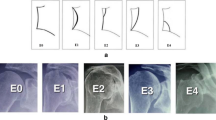Abstract
Background
The indications for reverse shoulder arthroplasty have grown dramatically during the past decade. In a relevant proportion of cases, there are accompanying significant glenoid bony defects.
Objectives
We aimed to review and summarize the current literature on the management of glenoid defects in reverse shoulder arthroplasties and to describe our approach.
Results
Currently, there are no treatment algorithms based on a specific classification system of glenoid defects in reverse shoulder arthroplasty published in the peer-reviewed literature. The authors distinguish between defects that are centric (contained), eccentric (uncontained). The literature mostly describes biological reconstruction of the defect by an autograft, with only a few allograft cases reported. Furthermore, it is unclear whether the procedure can be performed in a one- (glenoid defect reconstruction and implantation of reverse shoulder) or two-stage approach. We prefer a one-stage procedure if there is sufficient fixation of the central peg of the metaglene and good locking screw fixation in the native scapula. In advanced defects, specific glenoid base plates with a longer peg are necessary. In the literature and in our experience, the complication rate for this indication is not higher than with reverse arthroplasties without glenoid defects. Metal-augmented glenoid base plates are a possible alternative to biological reconstruction.
Conclusion
Glenoid defects concomitant with reverse shoulder arthroplasties represent a significant percentage of surgically difficult-to-treat patients. It is critical to distinguish between the different types of glenoid defects and to adjust the surgical procedure to the individual defect. In the majority of cases, a one-stage procedure is possible by using specific glenoid base plate designs.
Zusammenfassung
Hintergrund
In den letzten 10 Jahren hat die Zahl der Indikationen zur inversen Schulterendoprothesenversorgung deutlich zugenommen. In einem bedeutenden Teil der Fälle bestehen wesentliche begleitende Knochendefekte des Glenoids.
Ziel der Arbeit
Ziel war ein zusammenfassender Überblick über die aktuelle Literatur zur Behandlung von Glenoiddefekten bei der inversen Schulterendoprothesenversorgung und die Beschreibung des eigenen Ansatzes.
Ergebnisse
Derzeit gibt es in der Literatur keine Therapiealgorithmen auf der Grundlage eines spezifischen Klassifikationssystems von Glenoiddefekten bei inverser Schulterendoprothesenversorgung. Die Autoren unterscheiden zwischen zentrischen (eingefassten) und exzentrischen (nicht eingefassten) Defekten. In der Literatur wird meist die biologische Rekonstruktion des Defekts mittels Autograft beschrieben, nur einige wenige Fälle mit einem Allograft sind dokumentiert. Darüber hinaus ist es unklar, ob das Verfahren einzeitig (Glenoiddefektrekonstruktion und Implantation der inversen Schulterendoprothese) oder zweizeitig durchgeführt werden kann. Die Autoren bevorzugen ein einzeitiges Vorgehen, wenn eine ausreichende Fixation des zentralen Metaglene-Zapfens und gute Fixation mit winkelstabilen Schrauben in der nativen Skapula möglich ist. Bei fortgeschrittenen Defekten sind spezielle Glenoidbasisplatten mit einem längeren Zapfen notwendig. In der Literatur und nach Erfahrung der Autoren ist die Komplikationsrate für diese Indikation nicht höher als bei inverser Prothesenversorgung ohne Glenoiddefekt. Metallverstärkte Glenoidgrundplatten sind eine mögliche Alternative zur biologischen Rekonstruktion.
Schlussfolgerung
Patienten mit Glenoiddefekt und gleichzeitiger inverser Schulterprothesenversorgung stellen einen signifikanten Anteil der schwierig zu behandelnden chirurgischen Patienten dar. Es ist entscheidend, zwischen den verschiedenen Typen von Glenoiddefekten zu unterscheiden und das chirurgische Vorgehen auf den jeweiligen Defekt gezielt auszurichten. In der Mehrheit der Fälle ist ein einseitiges Vorgehen mit Verwendung eines speziellen Designs der Glenoidgrundplatte möglich.









Similar content being viewed by others
References
Antuna SA, Sperling JW, Cofield RH, Rowland CM (2001) Glenoid revision surgery after total shoulder arthroplasty. J Shoulder Elbow Surg 10:217–224
Bateman E, Donald SM (2012) Reconstruction of massive uncontained glenoid defects using a combined autograft-allograft construct with reverse shoulder arthroplasty: preliminary results. J Shoulder Elbow Surg 21(7):925–934. doi:10.1016/j.jse.2011.07.009
Bercik MJ, Kruse K, Yalizis M, Gauci M, Chaoui J, Walch G (2016) A modification of the Walch classification of the glenoid in primary glenohumeral osteoarthritis using three-dimensional imaging. J Shoulder Elbow Surg 25:1601–1606
Boileau P, Watkinson DJ, Hatzidakis AM, Balg F (2005) Grammont reverse prosthesis: design, rationale, and biomechanics. J Shoulder Elbow Surg 14(1 Suppl S):147S–161S (Review)
Boileau P, Moineau G, Roussanne Y, O’Shea K (2011) Bony Increased-Offset Reversed Shoulder Arthroplasty (BIO-RSA): Minimizing scapular impingement while maximizing glenoid fixation. Clin Orthop Relat Res 469(9):2558–2567. doi:10.1007/s11999-011-1775-4
Codsi MJ, Iannotti JP (2008) The effect of screw position on the initial fixation of a reverse total shoulder prosthesis in a glenoid with a cavitary bone defect. J Shoulder Elbow Surg 17(3):479–486
Deutsch A, Abboud JA, Kelly J, Mody M, Norris T, Ramsey ML, Iannotti JP, Williams GR (2007) Clinical results of revision shoulder arthroplasty for glenoid component loosening. J Shoulder Elbow Surg 16:706–716
Elhassan B, Ozbaydar M, Higgins LD, Warner JJ (2008) Glenoid reconstruction in revision shoulder arthroplasty. Clin Orthop Relat Res 466:599–607
Frankle MA, Teramoto A, Luo ZP, Levy JC, Pupello D (2009) Glenoid morphology in reverse shoulder arthroplasty: classification and surgical implications. J Shoulder Elbow Surg 18(6):874–885
Harman M, Frankle M, Vasey M, Banks S (2005) Initial glenoid component fixation in “reverse” total shoulder arthroplasty: a biomechanical evaluation. J Shoulder Elbow Surg 14(1 Suppl S):162S–167S
Hattrup SJ (2009) Revision total shoulder arthroplasty for painful humeral head replacement with glenoid arthrosis. J Shoulder Elbow Surg 18:220–224
Hill JM, Norris TR (2001) Long-term results of total shoulder arthroplasty following bone-grafting of the glenoid. J Bone Joint Surg Am 83-A:877–883
Hoenig MP, Loeffler B, Brown S, Peindl R, Fleischli J, Connor P, D’Alessandro D (2010) Reverse glenoid component fixation: Is a posterior screw necessary? J Shoulder Elbow Surg 19(4):544–549
Holcomb JO, Cuff D, Petersen SA, Pupello DR, Frankle MA (2009) Revision reverse shoulder arthroplasty for glenoid baseplate failure after primary reverse shoulder arthroplasty. J Shoulder Elbow Surg 18(5):717–723
Huguet D, Favard L, Lautmann S et al (2001) Épidémiologie, imagerie, classification de l’omarthrose avec rupture massive et non réparable de la coiffe. In: Walch G, Boileau P, Molé D (eds) 2000 shoulder prostheses 2–10 year follow-up. Sauramps Medical, Montpellier, pp 233–240
Humphrey CS, Kelly JD 2nd, Norris TR (2008) Optimizing glenosphere position and fixation in reverse shoulder arthroplasty, part two: the three-column concept. J Shoulder Elbow Surg 17(4):595–601
Jones RB, Wright TW, Roche CP (2015) Bone grafting the glenoid versus use of augmented glenoid baseplates with reverse shoulder arthroplasty. Bull Hosp Jt Dis 73(Suppl 1):S129–S135
Jones RB, Wright TW, Zuckerman JD (2016) Reverse total shoulder arthroplasty with structural bone grafting of large glenoid defects. J Shoulder Elbow Surg 25(9):1425–1432. doi:10.1016/j.jse.2016.01.016
Kelly JD 2nd, Humphrey CS, Norris TR (2008) Optimizing glenosphere position and fixation in reverse shoulder arthroplasty, part one: the twelve-mm rule. J Shoulder Elbow Surg 17(4):589–594
Klein SM, Dunning P, Mulieri P, Pupello D, Downes K, Frankle MA (2010) Effects of acquired glenoid bone defects on surgical technique and clinical outcomes in reverse shoulder arthroplasty. J Bone Joint Surg Am 92(5):1144–1154
Königshausen M, Jettkant B, Sverdlova N, Ehlert C, Gessmann J, Schildhauer TA, Seybold D (2015) Influence of different peg length in glenoid bone loss: A biomechanical analysis regarding primary stability of the glenoid baseplate in reverse shoulder arthroplasty. Technol Health Care 23(6):855–869. doi:10.3233/THC-151031
Neyton L, Boileau P, Nove-Josserand L, Edwards TB, Walch G (2007) Glenoid bone grafting with a reverse design prosthesis. J Shoulder Elbow Surg 16:S71–S78
Phipatanakul WP, Norris TR (2006) Treatment of glenoid loosening and bone loss due to osteolysis with glenoid bone grafting. J Shoulder Elbow Surg 15:84–87
Seebauer L, Goebel M (2005) Management of glenoid defects in reversed shoulder arthroplasty. Annual Meeting of the European Society of Shoulder and Elbow Surgery (SECEC), Rome.
Seebauer L, Goebel M (2008) Treatment strategies for chronic glenoid defects following anterior and posterior shoulder dislocation. Oper Orthop Traumatol 20(6):500–510
Seebauer L, Goebel M, Baier G (2009) Reverse shoulder arthroplasty and simultaneous glenoid reconstruction. Annual Meeting of the American Academy of Orthopaedic Surgeons (AAOS), Las Vegas.
Seebauer L (2011) Management of Glenoid Bone loss in primary and revision reverse TSA. Instructional course lectures # 328. Annual Meeting of the American Academy of Orthopaedic Surgeons (AAOS), San Diego, USA
Walch G, Badet R, Boulahia A, Khoury A (1999) Morphologic study of the glenoid in primary glenohumeral osteoarthritis. J Arthroplasty 14:756–760
Williams GR, Iannotti JP (2007) Options for glenoid bone loss: composites of prosthetics and biologics. J Shoulder Elbow Surg 16:267S–272S
Werner BS, Böhm D, Abdelkawi A, Gohlke F (2014) Glenoid bone grafting in reverse shoulder arthroplasty for long-standing anterior shoulder dislocation. J Shoulder Elbow Surg 23:1655–1661
Author information
Authors and Affiliations
Corresponding author
Ethics declarations
Conflict of interest
L. Seebauer and A.L. Ekelund are consultants and receive royalties from DePuy-Synthes.
This article does not contain any studies with human participants or animals performed by any of the authors.
Rights and permissions
About this article
Cite this article
Seebauer, L., Ekelund, A.L. Management of glenoid bone loss in primary and revision reverse total shoulder arthroplasty. Obere Extremität 12, 6–15 (2017). https://doi.org/10.1007/s11678-017-0396-2
Published:
Issue Date:
DOI: https://doi.org/10.1007/s11678-017-0396-2
Keywords
- Arthroplasty
- Shoulder
- Glenoid defect
- Reconstructive surgery
- Grafting, bone
- Reverse total shoulder arthroplasty




